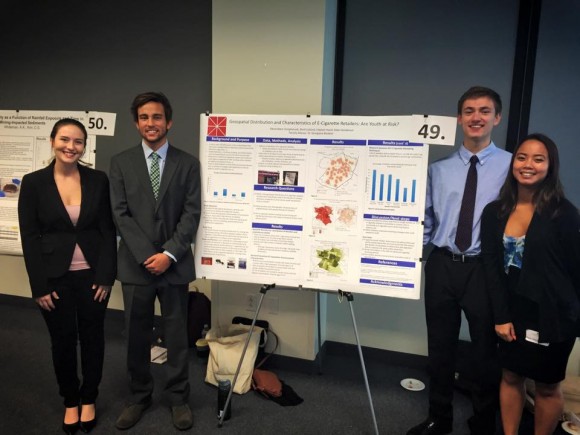E-cigarettes, Youth and Retailer Proximity to Schools
May 28, 2015
This year I participated as the student leader for
Dr. Georgiana Bostean
’s Social Determinants of Health research lab. Over two semesters, we studied the new phenomenon of electronic cigarette use and the potential risks it poses to youth.
The research team applied our knowledge of Geographic Information Systems (GIS) to studying the density and proximity of e-cigarette retailers to schools. We also looked at how e-cigarette retailers employed marketing strategies that may attract youth (based on findings from studies of traditional cigarettes). We presented this research at the
2015 Pacific Sociological Association
meeting in Long Beach, CA, and at the
Chapman University Student Research Day
.
Our core research team consisted of two other students: Brett Galland and Clayton Heard. This is their story:
Brett Galland
I have now completed a full academic year in the Social Determinants of Health lab studying e-cigarette retailers in Orange County, specifically
how retailer proximity to schools is associated with youth e-cigarette use
. I joined the research team because I wanted formal, academic research experience, and because I wanted to learn more about the growing e-cigarette craze. This research opportunity allowed me to strengthen my Geographic Information System skills and analyze meaningful data at the local level.
I was part of a motivated research team dedicated to learning how e-cigarette retailer practices and retailer proximity to schools might impact youth behavior such as the decision to start smoking. The rationale for our research is that e-cigarette use and experimentation is now more widespread than traditional cigarettes in some demographic groups such as high school students. Through observation on our campus alone, it is clear that e-cigarette use has a decent following and that users don’t necessarily understand the health implications of use.

During the fall semester, we examined Santa Ana retailers in depth and we not only learned what types of practices were prevalent, but we also witnessed first-hand the environment surrounding e-cigarette retailers.
This spring, we decided to expand the scope of our study to all of Orange County to examine proximity and density of retailers to public and private middle and high schools. We utilized survey data on e-cigarette use and retailer and school location data to demonstrate how youth are at risk of trying e-cigarettes. Our major finding was that
adding one e-cigarette retailer within a .25 mile radius of a school increases the chance of trying e-cigarettes by over 30%
, based on a multi-level regression model controlling for individual characteristics factors.
After a years’ worth of research, what will stick with me the most besides my wonderful research team, is the e-cigarette retailers and their practices. I learned a lot about these stores and the people that run them as well as some fun facts about e-cigarettes. For example, I learned that there is a large national vape cloud championship that awards users for the largest vapor cloud and best tricks. Research in general is a positive experience, and I was lucky enough to study a very important trend in our society and learn more about a topic I find intriguing.
Clayton Heard
I didn’t think I would spend my junior year of college visiting e-cig retailers around Orange County. I didn’t think I would find my self on Saturday mornings driving to San Clemente and looking at walls of different flavors of e-cig juice. And I really didn’t think I would see a promotion that offered 10% off e-cig’s with a student ID.

After a year in Dr. Bostean’s Social Determinants of Health Lab, I have learned and accomplished many things. The research team took an observation from the California Healthy Kids Survey, that
e-cigarette usage had surpassed traditional smoking
along with an observation from our surroundings that e-cigarette retailers seem to be popping up everywhere.
After reading some literature about youth targeted marketing strategies from the tobacco companies and national perceptions of e-cigarettes, we began to see a problem. Are e-cigarette retailers targeting youth? With little to no regulation on where e-cigarette retailers can be located, cities are allowing e-cig retailers to open near schools. In many cities, locations of tobacco stores are restricted based on studies finding that proximity to schools increases youth experimentation with cigarettes.
Using the GIS software, ArcMap, the research team geocoded, or mapped, the locations of every public and private school in Orange County, over 400 schools total, as well as every individual e-cig retailer. We then calculated a quarter mile and half mile buffer around the schools to estimate how many e-cig retailers were located within “walking distance” of students who possibly walk home from school.
What we found based on the California Healthy Kids Survey data, was that
as the number of e-cig retailers in the buffer increased, the more likely the student had ever tried an e-cig
.
When visiting the retailers we filled out a survey to record the different retailer characteristics, especially those we thought to be targeting youth. This was the most eye-opening experience for me because I had never been in a smoke shop before and to me the whole thing just seemed sketchy. I was only asked for ID once throughout the entire field visits. It seems to me like there needs to be some regulation as to where e-cigarettes can be sold and what health messages should be posted.
I learned what it is like to work in a research lab and will never look at e-cigarettes the same way. This project was a great extension from the Introduction to GIS course I took last year. It applied the concepts and skills to a real world spatial issue.



